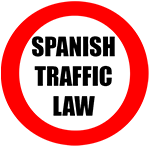1. Signs on vehicles are intended to inform the users of the road of certain circumstances or characteristics of the vehicle on which they are placed, the service provided, the load transported or about the driver.
2. Regardless of those required by other specific regulations, the nomenclature and meaning of the signs on the vehicles are the following:
V-1. Priority vehicle. Indicates that it is a vehicle of the police, fire fighters, civil protection and rescue or health care services, in urgent service, if it is used simultaneously with the special acoustic warning device, which regulations governing vehicles are equipped with.
V-2. Vehicles for road works or services, agricultural tractors, agricultural machinery, other special vehicles, special transportation and military convoys. Indicates that it is a vehicle of this class, in service, a special transportation or military convoy.
V-3. Police vehicle. Indicates a vehicle of this class in non-emergency service.
V-4. Speed limit. Indicates that the vehicle must not travel at a higher speed, in kilometres per hour, than the figure shown in the signal.
V-5. Slow vehicle. Indicates that it is a motor vehicle, or set of vehicles, which, by construction, cannot exceed the speed of 40 kilometres per hour.
2. This signal, which will be installed in the rear part of the vehicle, will be optional for motor vehicles or groups of vehicles that must carry the V-4 speed limitation signal.
V-6. Long vehicle. Indicates that the vehicle or set of vehicles has a length greater than 12 metres.
V-7. Spanish nationality. Indicates that the vehicle is registered in Spain.
If you have a vehicle with a Spanish licence plate of the old format without the European logo, you will have to paste, on the back of the vehicle, the V-7 “E” sticker corresponding to Spain, to identify the country of origin of the vehicle when you travel outside of Spain.
V-8. Foreign nationality. Indicates that the vehicle is registered in the country to which the acronyms it contains correspond, and that the installation of this is mandatory in order to travel through Spain.
If you have a foreign vehicle with the license plate that lacks the European logo, you must affix the sticker of your country on the back to indicate the country of origin of that vehicle.
V-9. Public service. Indicates that the vehicle is dedicated to providing public services. The use of this sign will only be required when the regulations of the public service in question so dictate.
V-10. School transportation. Indicates that the vehicle is performing this kind of transportation.
V-11. Transport of dangerous goods. Indicates that the vehicle transports dangerous goods.
Upper part; Danger identification number (2 or 3 digits)
Bottom part; Material identification number (4 digits)
V-12. Test or investigation plaque. Indicates that the vehicle is performing special tests or investigative tests.
V-13. Novice driver. Indicates that the vehicle is driven by a person whose driving licence is less than one year old.
You must place the signal in the upper right rear part (from the inside), and in case you drive a vehicle with tinted windows or a boxcar, you must acquire an approved sticker and place it on the right rear part.
Remember that the V-13 signal must be placed on any vehicle you drive, irrespective of whether you are the owner.
V-14. Learner driver. Indicates that the vehicle is being driven according to the learning of driving or aptitude tests.
V-15. Disabled. Indicates that the driver of the vehicle is a person with disabilities that reduce their mobility and that, therefore, can benefit from the facilities that general or specifically granted.
V-16. Pre-signalling danger device. Indicates that a vehicle has been immobilised in the roadway or that its cargo has been dropped from it.
V-17. Free indicator lighting. It indicates that the taxi driving is in conditions to be rented.
V-18. Taximeter lighting. This is destined, in passenger cars for public passenger service, to illuminate the metre counter as soon as the flag descent occurs.
V-19. Badge of periodic techn nbical inspection of the vehicle. Indicates that the vehicle has passed the periodic technical inspection, as well as the date on which the next inspection should pass.
V-20. Panel for protruding loads. Indicates that the vehicle’s load protrudes behind it.
V-21. Advise sign for special transport accompaniment. Advertises a special transportation.
V-22. Cyclists escort warning sign. Indicates the upcoming movement of cyclists.
V-23. Badge of goods transport vehicles. Indicates a vehicle of this class. It will consist of reflective markings used to increase the visibility and recognition of long and heavy trucks and vehicles and their trailers. The badge of the transport vehicles must comply with the provisions for this sign in Annex XI of the General Vehicle Regulations.
3. The shape, colour, design, symbols, dimensions, meaning and placement of the signals on the vehicles shall comply with the provisions of Annex XI of the General Vehicle Regulations.
